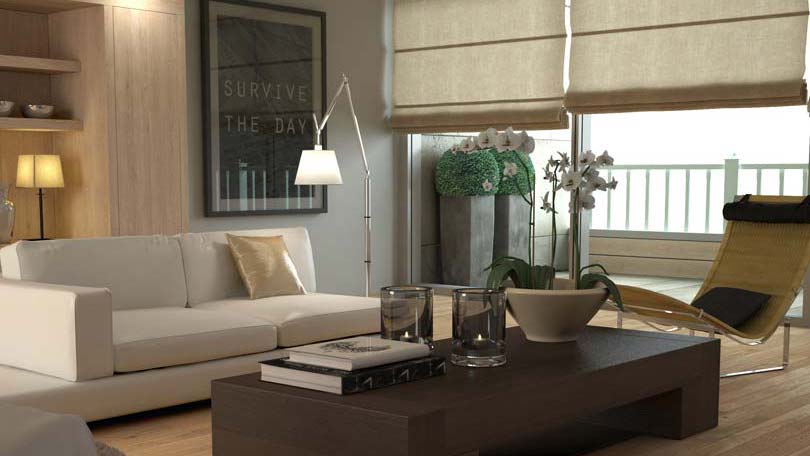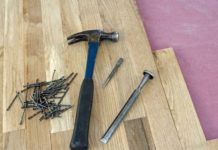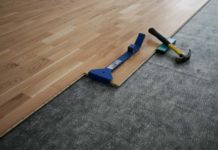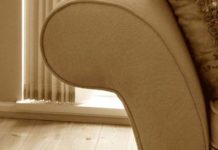
1 Strip, 2 Strip, 3 Strip flooring – What the heck is that? Simple really; 3 Strip flooring is made of assembled pieces of 2 5/8’ hardwood flooring veneers assembled and glued together to create “longstrips” or boards that are up to 95 3/8” long and 3 strips wide, or 7 7/8”. Usually the pieces used to create 3 strip flooring are shorter pieces or “fillets” left over from longer cuts. The finished board looks a lot like a butcher block, which is also made of assembled pieces (although usually end grain
The beauty of 3 strip flooring, is that you get a dramatic, multi-piece look with the ease of installing a wide plank, long board floor. And of course, the stability of a factory-glued product that is built and glued under pressure to perform like one solid piece of wood, only better, because it is all assembled on top of dimensionally-stable multi-layer plywood. So you get almost none of the warping, cracking, expansion and contraction common with solid wood floors.
3 strip engineered floors feature a snap-fit installation that varies by manufacturer but ensures a tight, machined fit for ease of assembly. Glue down or floating floors are the recommended methods for installing 3 strip. And naturally, you would choose floating over any radiant heating to accommodate the wider temperature range.
Achieve a Dramatic Wood Floor Look Anywhere
One of the beauties of engineered 3 strip flooring is that it can be installed almost anywhere, and certainly more places than solid plank flooring. Engineered floors are being installed over cement subfloors and even in basements, where heretofore, wood floors were not an option. What has changed? Let’s take a look.
Basements used to present a host of problems for potential wood floor installation, and thus alternatives were usually prescribed. Perhaps the biggest obstacle was moisture that might seep up from the slab or below-grade walls. But nowadays, modest moisture can be mitigated by sealers. A note about sealers: Make certain that if your installation is to be a glue down, that you buy a sealing/adhesive system from one manufacturer that will work in concert together. In the past, certain sealers held the moisture at bay, but repelled the adhesive over top, thus ruining the final installation by preventing a good bonding of the flooring to the subfloor.
Heavy moisture may require some actual engineering such as a low-point sump set below the slab, and/or French drains set around the foundation to help runoff, well, runoff! Also vapor barriers such as plastic sheeting, taped at overlapped seams keeps modest slab moisture away from the flooring, but then requires a “floating” installation, where the flooring is locked together on its edge, but “floats” on a cushioned underlayment one top of the subfloor. Some underlayments now come with a moisture barrier built in to give the homeowner a simple one-step preparation for laying the final floor.
Floating installations, (like glue downs), avoid the necessity of nailing or stapling into the subfloor. When the subfloor is cement, this is a good thing! So with these advances in sealing, adhesion, and installation techniques, we’re now seeing dramatic wood floors in spaces that would have been deemed impossible just a few short years ago.
Radiant Heat Precautions
3 strip flooring can be installed over radiant heat systems – either electric or hot water tube systems set into the subfloor – with the following precautions.
1.Keep humidity at proper levels, between 45 and 60% in the room, to keep the wood from drying out or cracking. In a basement application, you may need humidifiers, dehumidifiers, fans or open windows to assist in maintaining these levels.
2.Bring the heat on slowly the first time you use it with your new floor. Give the 3 strip engineered floor time to adjust to the radiant heat by waiting two full days before turning it on, then raising the heat slowly over the next 7-10 days incrementally until you reach your optimum heating level.
3.Don’t crank the heat! Keep your radiant heating at 81 degrees or below.
Following these simple precautions will give you years of worry-free enjoyment from any engineered floor set over a radiant heating system.
Why 3 Strip Flooring?
With all the hardwood flooring available today, why would you choose 3 strip as your floor of choice? Let’s explore this a little deeper.
With the exception of parquet or wood mosaic applications, most all wood flooring is longitudinally oriented, or to put it simply, is sold in longer strips of boards with the grain running lengthwise. These floors work great oriented into the incoming light, such as windows, and tend to “lengthen” the view walking into a room. We’ve come to expect this orientating of length and grain in flooring, and find it appealing and comforting.
3 strip flooring is also longitudinally oriented with the grain running lengthwise, HOWEVER, the pieces that comprise the longer board are short, random length, AND random color strips that create a busy, unexpected look. The different strips set up a staccato visual rhythm of dark/light, grain/knots, highlights/subtle areas that’s a knockout to behold. This is especially true with medium colored woods like oak, jarrah, walnut, and ash, where lighter “fillets” are juxtaposed with darker pieces, making a kaleidoscope of natural wood color and grain that’s a joy to behold.
Also be sure to purchase any trim pieces at the same time, and from the same vendor, such as reducers, end caps, T molding, Shoe molding, overlap stair nosing, and bull nosing. This will ensure that your project is “in tune” visually, and presents a complete, unified picture. Go ahead, be bold … try a 3 strip project of your own!





